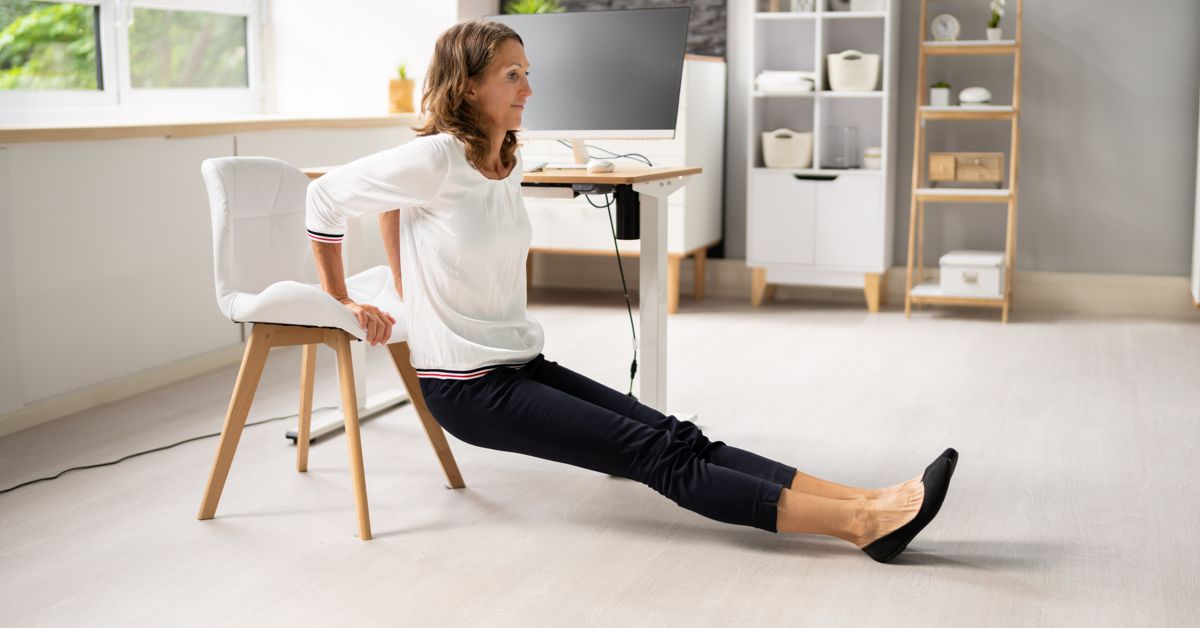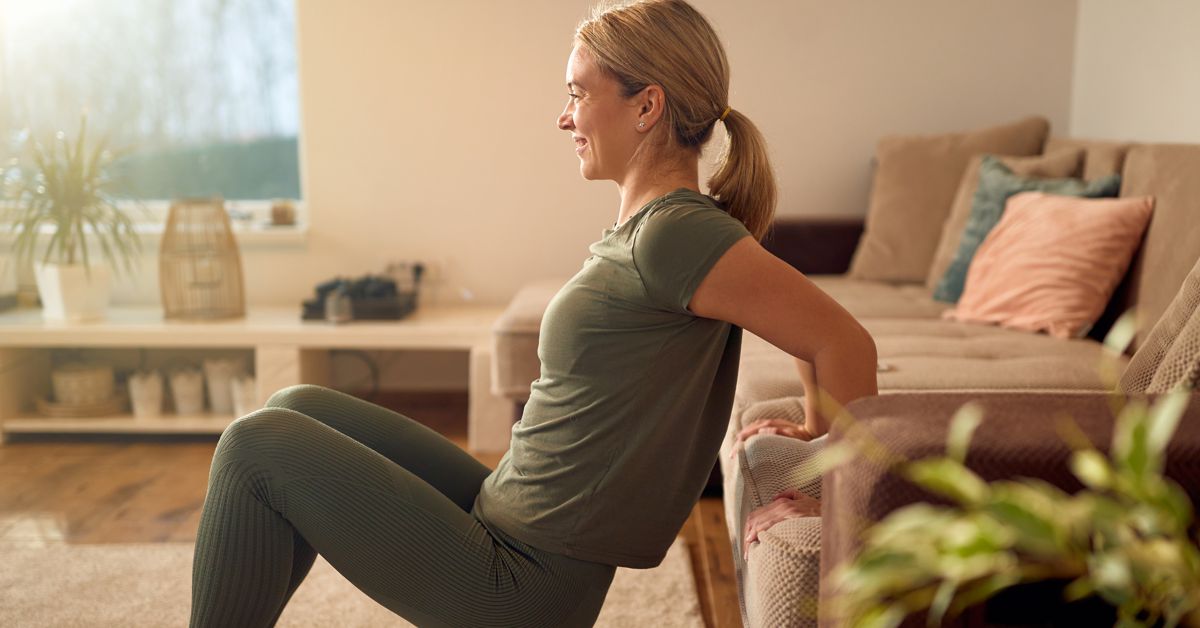Bodyweight dips are a great way to strengthen your arms, shoulders and back muscles.
This simple yet effective move can be done almost anywhere, making it a convenient exercise to add to your routine.
Bodyweight dips require no equipment, making them perfect for working out at home or on the go.
The bodyweight dip is a great pushing exercise for triceps development and can be performed with two parallel bars or with parallel bars that are on the ground.
This exercise is simple to perform but extremely effective at building strong, defined triceps.
To perform bodyweight dips, you will need a dip station or two parallel bars that are close enough together for you to comfortably hold onto with your hands.
If you don't have access to a dip station, you can use a pair of sturdy chairs or benches that are positioned close together.
Bodyweight dips can be challenging, especially for beginners.
If you find the exercise too difficult, you can modify it by performing the dips with your knees bent and your feet on the ground.
This will make the exercise easier by reducing the amount of weight you need to lift.
As you get stronger, you can gradually straighten your legs and cross your feet to make the exercise more challenging.
It's important to keep good form during bodyweight dips to avoid injury and get the most out of the exercise.
Be sure to keep your body straight and avoid swinging or using momentum to lift yourself.
It's also important to engage your core and keep your shoulders down and away from your ears.
What muscles work during dips?
The pectoral muscles, anterior deltoids, triceps, and latissimus dorsi are the major muscle groups that work during this exercise.
These muscles are used to lower and raise the body up and down. As you exercise, it is important to focus on contracting the muscles in your pelvic floor.
By doing this, you can get the most benefit from the workout and improve your overall health.
The anterior deltoid is the muscle located in the front of the shoulder that works to lower the arm down to the ground.
The pectoralis major and rectus abdominis are the muscles located in the chest and stomach, respectively, that work together to push the body up from the ground.
The pectoralis major is a large, triangular muscle that covers much of the chest wall and inserts into the humerus.
The rectus abdominis is a long, flat muscle that extends along the entire length of the abdomen.
How to execute a dip
To begin the exercise, stand between the dip bars and grip them securely with your hands.
Your palms should be facing inward, with your fingers wrapped around the bars.
From this starting position, bend your knees slightly and cross your feet at the ankles. This will help to stabilize your body and prevent swinging.
Next, straighten your arms and lift yourself up off the ground by pushing down on the dip bars.
Your body should be straight and parallel to the ground. This is the starting position for the exercise.
To perform the dip, slowly lower your body by bending your elbows and lowering your hips toward the ground.
Keep your body straight and your feet crossed at the ankles.
Once your elbows are bent to a 90-degree angle, pause briefly and then press down on the dip bars to straighten your arms and raise your body back to the starting position
Common mistakes while doing dips
Bodyweight dips are a type of strength training exercise that primarily targets the triceps muscles in the upper arms.
To do the exercise, you will need a dip bar or two parallel bars that are at a height where you can comfortably hold yourself above the bars with your arms extended.
From this starting position, you will lower your body down until your arms form a 90-degree angle, and then push back up to the starting position.
One common mistake people make while doing bodyweight dips is not using the full range of motion.
This means not lowering the body far enough, which can reduce the effectiveness of the exercise.
To avoid this mistake, make sure you lower your body until your upper arms are parallel to the floor.
Another common mistake is not keeping the body straight, which can lead to swinging and loss of balance.
To avoid this, focus on maintaining a straight line from your head to your heels, and avoid arching your back or swinging your legs.
Using too much momentum and not controlling the movement is also a common mistake.
This can cause you to swing your body and use momentum to lift yourself up, which can reduce the challenge of the exercise and lead to poor form.
To avoid this, focus on using your triceps to lift your body and control the movement.
Failing to engage the triceps is another common mistake. This can lead to strain on the elbow joint and reduce the effectiveness of the exercise.
To avoid this, focus on engaging your triceps and pushing through your palms as you lift your body.
Rounding the shoulders is another mistake people often make while doing bodyweight dips.
This can cause strain on the shoulders and upper back, and can also reduce the challenge of the exercise.
To avoid this, focus on keeping your shoulders back and down, and avoid hunching them forward.
What are the benefits of doing dips?
Bodyweight dips are a type of strength training exercise that primarily targets the triceps muscles in the upper arms. This exercise can provide several benefits, including:
- Improved upper body strength, particularly in the triceps, chest, and shoulders Increased muscle mass in the upper body
- Improved posture and core stability
- Increased functional strength for activities such as pushing, pulling, and carrying
- Improved performance in other exercises that rely on triceps strength, such as push-ups and bench press
In addition to these physical benefits, bodyweight dips can also provide a sense of accomplishment and can be a fun and challenging way to add variety to your workout routine.

Can Bodyweight dips affect your shoulders?
Bodyweight dips are a great exercise for building strength in the chest, triceps, and shoulders.
It is a very challenging exercise and can be done anywhere. But the question is: can bodyweight dips affect your shoulders?
The answer to this question is not straightforward. It depends on how you execute the exercise and whether you have any pre-existing shoulder issues.
If you have pre-existing shoulder issues, then it is advisable to consult with a physician before starting any new exercises.
Depending on how you execute the exercise, it could either help or hurt your shoulders.
As long as you perform bodyweight dips in a proper way, they can be done without any issues to your shoulders.
You should maintain a straight back, keep your elbows close to your sides and not allow them to flare out too much, and keep your head up with eyes looking forward throughout the motion.
This will help ensure that you are using proper form and executing the dip correctly without putting undue stress on your shoulder joints.
By keeping good form, you can prevent injury to your shoulders and execute the dip correctly.
Who shouldn't do bodyweight dips?
Bodyweight dips can be a challenging exercise and may not be suitable for everyone, especially if you have certain medical conditions or physical limitations.
It's always best to consult with a healthcare professional before starting a new exercise routine, and to listen to your body and stop if you experience any pain or discomfort.
Some people who may not be able to safely perform bodyweight dips include:
- Those with chronic conditions, such as heart disease, diabetes, or high blood pressure
- Those with joint problems, such as arthritis or chronic pain in the shoulders, elbows, or wrists
- Those with back or neck injuries
- Those who are pregnant or have recently given birth
- Those who are recovering from surgery
- Those who are very overweight or obese
If you have any concerns about your ability to perform bodyweight dips, it's best to speak with a healthcare professional or a certified personal trainer.
They can provide guidance and advice on how to safely incorporate this exercise into your workout routine.
How about progressions?
If you're new to bodyweight dips, it's important to start slowly and progress gradually to avoid injury and ensure that you're able to properly execute the exercise with good form.
Here are a few tips for how to progress with your dips:
1. Begin by practicing the starting position for the exercise.
Stand between the dip bars, grip them securely with your palms facing inward, and bend your knees slightly while crossing your feet at the ankles.
Hold this position for a few seconds to get a feel for the exercise and to ensure that you're stable and balanced.
2. Once you're comfortable with the starting position, try performing a few dips with your knees bent and your feet on the ground.
This will make the exercise easier by reducing the amount of weight you need to lift.
Keep your body straight and your elbows close to your sides as you lower and raise your body.
3. As you get stronger and more comfortable with the exercise, gradually straighten your legs and cross your feet at the ankles to increase the challenge.
Keep your body straight and your core engaged as you perform the dips.
4. To further increase the difficulty of the exercise, you can try adding weight by holding a dumbbell or weight plate between your feet or wearing a weighted vest.
Be sure to progress gradually and only add weight when you feel comfortable and able to maintain good form.
5. Finally, to challenge yourself even further, you can try performing dips on uneven bars or rings, which will require you to engage your core and stabilizer muscles to maintain balance.
Remember to always listen to your body and stop if you experience any pain or discomfort.
It's better to progress slowly and safely than to push yourself too hard and risk injury.
A little favor
Thanks for reading! We encourage you to save our site in your bookmarks and share it if you liked the information found in this article.
Also, be sure to check out our Fitness section here on Woman Vitality for more articles just like this one.

Leave A Comment